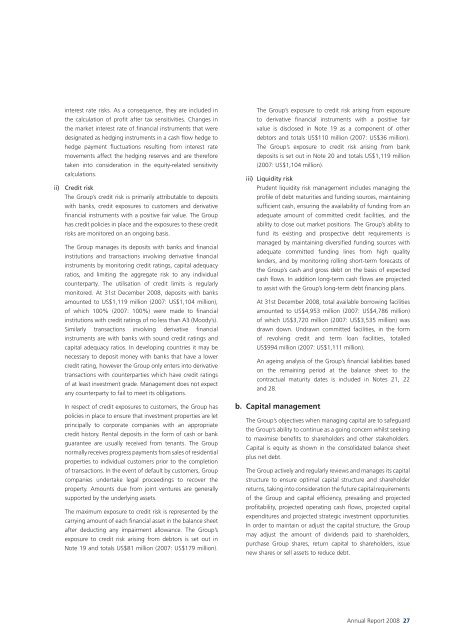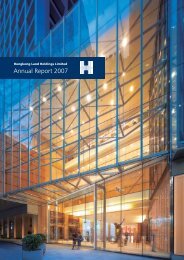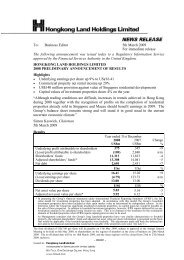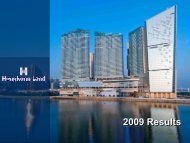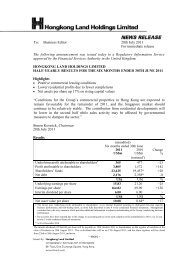in PDF - Hongkong Land
in PDF - Hongkong Land
in PDF - Hongkong Land
Create successful ePaper yourself
Turn your PDF publications into a flip-book with our unique Google optimized e-Paper software.
<strong>in</strong>terest rate risks. As a consequence, they are <strong>in</strong>cluded <strong>in</strong><br />
the calculation of profit after tax sensitivities. Changes <strong>in</strong><br />
the market <strong>in</strong>terest rate of f<strong>in</strong>ancial <strong>in</strong>struments that were<br />
designated as hedg<strong>in</strong>g <strong>in</strong>struments <strong>in</strong> a cash flow hedge to<br />
hedge payment fluctuations result<strong>in</strong>g from <strong>in</strong>terest rate<br />
movements affect the hedg<strong>in</strong>g reserves and are therefore<br />
taken <strong>in</strong>to consideration <strong>in</strong> the equity-related sensitivity<br />
calculations.<br />
ii) Credit risk<br />
The Group’s credit risk is primarily attributable to deposits<br />
with banks, credit exposures to customers and derivative<br />
f<strong>in</strong>ancial <strong>in</strong>struments with a positive fair value. The Group<br />
has credit policies <strong>in</strong> place and the exposures to these credit<br />
risks are monitored on an ongo<strong>in</strong>g basis.<br />
The Group manages its deposits with banks and f<strong>in</strong>ancial<br />
<strong>in</strong>stitutions and transactions <strong>in</strong>volv<strong>in</strong>g derivative f<strong>in</strong>ancial<br />
<strong>in</strong>struments by monitor<strong>in</strong>g credit rat<strong>in</strong>gs, capital adequacy<br />
ratios, and limit<strong>in</strong>g the aggregate risk to any <strong>in</strong>dividual<br />
counterparty. The utilisation of credit limits is regularly<br />
monitored. At 31st December 2008, deposits with banks<br />
amounted to US$1,119 million (2007: US$1,104 million),<br />
of which 100% (2007: 100%) were made to f<strong>in</strong>ancial<br />
<strong>in</strong>stitutions with credit rat<strong>in</strong>gs of no less than A3 (Moody’s).<br />
Similarly transactions <strong>in</strong>volv<strong>in</strong>g derivative f<strong>in</strong>ancial<br />
<strong>in</strong>struments are with banks with sound credit rat<strong>in</strong>gs and<br />
capital adequacy ratios. In develop<strong>in</strong>g countries it may be<br />
necessary to deposit money with banks that have a lower<br />
credit rat<strong>in</strong>g, however the Group only enters <strong>in</strong>to derivative<br />
transactions with counterparties which have credit rat<strong>in</strong>gs<br />
of at least <strong>in</strong>vestment grade. Management does not expect<br />
any counterparty to fail to meet its obligations.<br />
In respect of credit exposures to customers, the Group has<br />
policies <strong>in</strong> place to ensure that <strong>in</strong>vestment properties are let<br />
pr<strong>in</strong>cipally to corporate companies with an appropriate<br />
credit history. Rental deposits <strong>in</strong> the form of cash or bank<br />
guarantee are usually received from tenants. The Group<br />
normally receives progress payments from sales of residential<br />
properties to <strong>in</strong>dividual customers prior to the completion<br />
of transactions. In the event of default by customers, Group<br />
companies undertake legal proceed<strong>in</strong>gs to recover the<br />
property. Amounts due from jo<strong>in</strong>t ventures are generally<br />
supported by the underly<strong>in</strong>g assets.<br />
The maximum exposure to credit risk is represented by the<br />
carry<strong>in</strong>g amount of each f<strong>in</strong>ancial asset <strong>in</strong> the balance sheet<br />
after deduct<strong>in</strong>g any impairment allowance. The Group’s<br />
exposure to credit risk aris<strong>in</strong>g from debtors is set out <strong>in</strong><br />
Note 19 and totals US$81 million (2007: US$179 million).<br />
The Group’s exposure to credit risk aris<strong>in</strong>g from exposure<br />
to derivative f<strong>in</strong>ancial <strong>in</strong>struments with a positive fair<br />
value is disclosed <strong>in</strong> Note 19 as a component of other<br />
debtors and totals US$110 million (2007: US$36 million).<br />
The Group’s exposure to credit risk aris<strong>in</strong>g from bank<br />
deposits is set out <strong>in</strong> Note 20 and totals US$1,119 million<br />
(2007: US$1,104 million).<br />
iii) Liquidity risk<br />
Prudent liquidity risk management <strong>in</strong>cludes manag<strong>in</strong>g the<br />
profile of debt maturities and fund<strong>in</strong>g sources, ma<strong>in</strong>ta<strong>in</strong><strong>in</strong>g<br />
sufficient cash, ensur<strong>in</strong>g the availability of fund<strong>in</strong>g from an<br />
adequate amount of committed credit facilities, and the<br />
ability to close out market positions. The Group’s ability to<br />
fund its exist<strong>in</strong>g and prospective debt requirements is<br />
managed by ma<strong>in</strong>ta<strong>in</strong><strong>in</strong>g diversified fund<strong>in</strong>g sources with<br />
adequate committed fund<strong>in</strong>g l<strong>in</strong>es from high quality<br />
lenders, and by monitor<strong>in</strong>g roll<strong>in</strong>g short-term forecasts of<br />
the Group’s cash and gross debt on the basis of expected<br />
cash flows. In addition long-term cash flows are projected<br />
to assist with the Group’s long-term debt f<strong>in</strong>anc<strong>in</strong>g plans.<br />
At 31st December 2008, total available borrow<strong>in</strong>g facilities<br />
amounted to US$4,953 million (2007: US$4,786 million)<br />
of which US$3,720 million (2007: US$3,535 million) was<br />
drawn down. Undrawn committed facilities, <strong>in</strong> the form<br />
of revolv<strong>in</strong>g credit and term loan facilities, totalled<br />
US$994 million (2007: US$1,111 million).<br />
An age<strong>in</strong>g analysis of the Group’s f<strong>in</strong>ancial liabilities based<br />
on the rema<strong>in</strong><strong>in</strong>g period at the balance sheet to the<br />
contractual maturity dates is <strong>in</strong>cluded <strong>in</strong> Notes 21, 22<br />
and 28.<br />
b. Capital management<br />
The Group’s objectives when manag<strong>in</strong>g capital are to safeguard<br />
the Group’s ability to cont<strong>in</strong>ue as a go<strong>in</strong>g concern whilst seek<strong>in</strong>g<br />
to maximise benefits to shareholders and other stakeholders.<br />
Capital is equity as shown <strong>in</strong> the consolidated balance sheet<br />
plus net debt.<br />
The Group actively and regularly reviews and manages its capital<br />
structure to ensure optimal capital structure and shareholder<br />
returns, tak<strong>in</strong>g <strong>in</strong>to consideration the future capital requirements<br />
of the Group and capital efficiency, prevail<strong>in</strong>g and projected<br />
profitability, projected operat<strong>in</strong>g cash flows, projected capital<br />
expenditures and projected strategic <strong>in</strong>vestment opportunities.<br />
In order to ma<strong>in</strong>ta<strong>in</strong> or adjust the capital structure, the Group<br />
may adjust the amount of dividends paid to shareholders,<br />
purchase Group shares, return capital to shareholders, issue<br />
new shares or sell assets to reduce debt.<br />
Annual Report 2008 27


